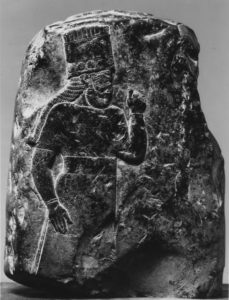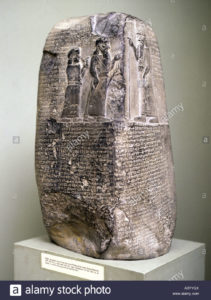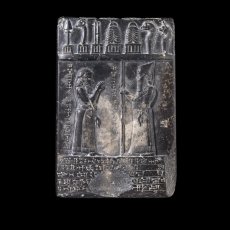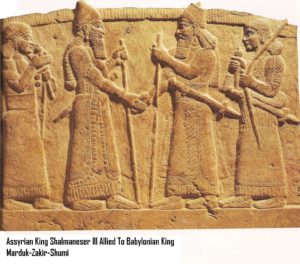The translation on this webpage was adapted from A.K. Grayson, Assyrian and Babylonian Chronicles (1975) and Jean-Jacques Glassner, Mesopotamian Chronicles (Atlanta, 2004).
(Texts: All Artifacts, Color Coding, & Writings in Bold Type With Italics Inside Parenthesis, are Added by Editor R. Brown, not the Authors, Translators, or Publishers!)
(gods in blue…mixed-breed demigods in teal)
The Eclectic Chronicle (ABC 24) is one of the historiographical texts from ancient Babylonia. It deals with events between 1080 and 822 that were important from a Babylonian point of view, but the exact purpose of this text is unclear. Some lines are duplicates of the Walker Chronicle.
The text of this chronicle is inscribed on a tablet, BM 27859 (98-7-11, 124), the top of which is missing. There is also a large piece missing from the lower left-hand corner. The preserved portion, about two thirds of the text, measures 45 mm wide and 60 mm long.
Translation of obverse
| Lacuna |
| 1′ […] |
| 2′ […] |
| 3′ he carried off a great booty. |
|
—————————————— |
 (King Marduk-nadin-ahhe, named for & servant to Babylonian patron god Marduk) (King Marduk-nadin-ahhe, named for & servant to Babylonian patron god Marduk)4′ Marduk-šapik-zeri (1,082-1,069 B.C.) [1], the son of Marduk-nadin-ahhe (1,100-1,082 B.C.), rebuilt the wall of Babylon. He conquered the |
| 5′ kings of the lands. During his reign, the people of the land enjoyed prosperity. |
| 6′ He made an entente cordiale with Aššur-bêl-kala, king of Assyria.[2] |
| 7′ At that time, the king went from Assyria to Sippar. |
|
—————————————— |
| 8′ Adad-apla-iddina (1,069-1,046 B.C.),[3] descendant of Itti-Marduk-balatu (1,146-1,132 B.C.), the Arameans and an usurper king rebelled against him |
| 9′ and desecrated all the sanctuaries centers of the land. Der, Dur-Anki (Nippur). |
| 10′ Sippar, Parsa (Dur-Kurigalzu) they demolished. The Suteans attacked and the booty of Sumer and Akkad |
| 11′ they took home. He made frequent visits to the shrines of Marduk and appeased his heart. He totally restored his cult |
|
—————————————— |
| 12′ Simbar-šihu, son of Eriba-Sin, knight of the Sealand, |
| 13′ made the throne of Enlil at Ekur-igigal. |
|
—————————————— |
| 14′ In the month of Nisannu of the fifth year of Eulmaš-šakin-šumi (1,004-987 B.C.), the king.[4] |
|
—————————————— |
| 15′ The fourteenth year [5] |
|
—————————————— |
| 16′ The fourth year of Mar-biti-apla-usur (985-979 B.C.) [6] |
|
—————————————— |
 (Nabu-mukin-apli & spouse before giant Marduk, alien Babylonian god) (Nabu-mukin-apli & spouse before giant Marduk, alien Babylonian god)17′ The first year of Nabû-mukin-apli (979-943 B.C.), the king [7] |
|
—————————————— |
| 18′ The Nth year |
| Edge |
| Lacuna |
Translation of reverse
| 1′ The Nth year of Mar-biti-ahhe-iddina (943-920 B.C.) [8] |
|
—————————————— |
| 2′ Adad-nirari was the king of Assyria at the time of Šamaš-mudammiq (920-900 B.C.).[9] |
|
—————————————— |
| 3′ At the time of Nabû-šuma-ukin (900-888 B.C.), Tukulti-Ninurta was the king of Assyria.[10] |
|
—————————————— |
 (King Nabu-apla-iddina stands before Marduk for instructions) (King Nabu-apla-iddina stands before Marduk for instructions)4′ At the time of Nabû-apla-iddina (888-855 B.C.), son of Nabû-šuma-ukin (900-888 B.C.), Aššur-nasir-apli was the king of Assyria.[11] |
|
—————————————— |
 (mixed-breed offspring descendant kings of the giant gods) (mixed-breed offspring descendant kings of the giant gods)5′ At the time of Marduk-zakir-šumi (855-819 B.C.), son of Nabû-apla-iddina, and |
| 6′ Marduk-bêl-usate, Šalmaneser II was the king of Assyria.[12] |
|
—————————————— |
| 7′ At the time of Marduk-balassu-iqbi (819-813 B.C.) and Marduk-zakir-šumi (855-819 B.C.) |
|
—————————————— |
| 8′ For N years there was no king in the land.[13] |
|
—————————————— |
| 9′ Eriba-Marduk (769-761 B.C.), descendant of Marduk-šakin-šumi, |
| 10′ took the hand of Bêl (Marduk) and the son of Bêl (Nabû) in his second year. |
| 11′ The Aramaeans who had taken by murder and insurrection the fields of the inhabitants of Babylon and Borsippa, |
| 12′ Eriba-Marduk slew by the sword, and he brought about their defeat. |
| 13′ He took the fields and orchards away from the and gave them to the [Arameans?] and Borsippeans. |
| 14′ In that same year, he set of the throne of Bêl (Marduk) in Esagila (Marduk’s residence in Babylon) and Ezida (Nabu’s residence in Borsippa) […] |
| 15′ […] Eriba-Marduk […] to Babylon. |
|
—————————————— |
| 16′ […] Eriba-Marduk went out from […] |
|
—————————————— |
| 17′ […] Nabû-Nasir (748-734 B.C.).[14] |
|
—————————————— |
| 18′ […] |
|
—————————————— |
| 19′ […] Tiglath-pileser III, king of Assyria, ascended the throne.[15] |
|
—————————————— |
| 20′ Šalmaneser, king of Assyria, ascended the throne.”[16] |
|
—————————————— |
| Lacuna |
Note 1:
King of Babylonia between 1081 and 1069.
Note 3:
Adad-apla-iddina was king of Babylonia from 1068 to 1047; Itti-Marduk-balatu from 1139 to 1132. The section is identical to several lines from the Walker Chronicle.
Note 4:
This king ruled from 1004 to 988; his fifth year is 1000 BCE.
Note 5:
In this period, only Eulmaš-šakin-šumi had more than thirteen regnal years, so his fourteenth year, 991 BCE) can be meant.
Note 6:
Mar-biti-apla-usur was king of Babylonia from 984 to 979; his fourth year is 981.
Note 7:
This king ruled from 978 to 943.
Note 8:
Became king of Babylonia in 942.
Note 9:
Adad-nirari II ruled from 911 to 891.
Note 10:
Tukulti-Ninurta II was king of Assyria in 890-884.
Note 11:
Aššur-nasir-apli II of Assyria reigned from 883 to 859.
Note 12:
Šalmaneser III of Assyria was king from 858 to 824. His contemporaries can not be dated more accurately.
Note 13:
In fact, an Assyrian king must have ruled over the country The events mentioned in the next section can not be dated exactly.
Note 14:
King of Babylonia, 747-734.
Note 15:
The first full regnal year of Tiglath-pileser III of Assyria is 744; he must have ascended in 745.
Note 16:
The first full regnal year of Šalmaneser V of Assyria is 726; he must have ascended in 727.